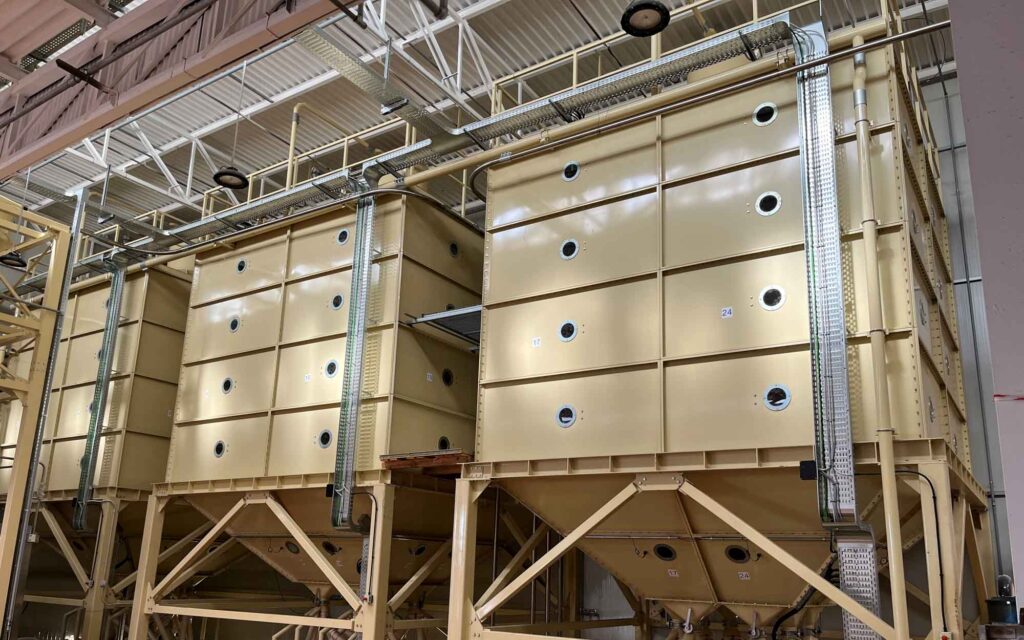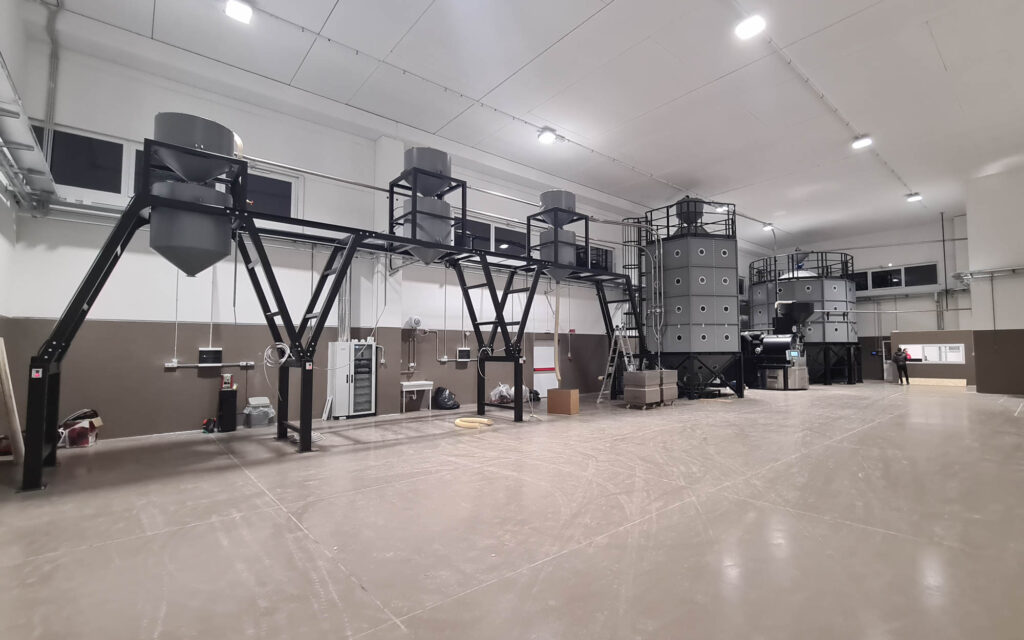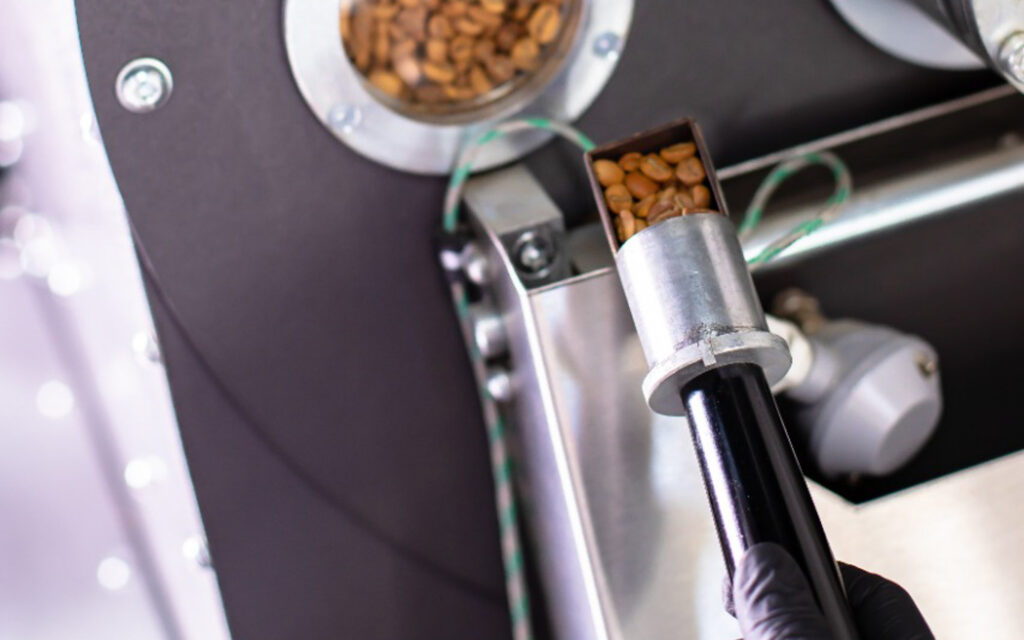How can roasters store and transport roasted coffee safely & effectively?
In any given specialty coffee roastery, there is plenty going on throughout every hour of every working day. And while roasting batches of coffee might be the first thing that comes to mind, there’s much more for roasters to consider.
Storing roasted coffee safely and effectively, as well as moving it around a roastery efficiently, are essential to the success of any roasting business. In line with this, roasters need to follow a set of best practices to protect the integrity of their coffee.
To find out more, I spoke with Roberto Pedini, Expert Process Manager at IMF Roasters. Read on for more of his insight into how roasters can best store and transport roasted coffee.
You may also like our article on how specialty roasters manage their green coffee supplies.

Why do roasters need to preserve roasted coffee quality and freshness?
Before coffee is roasted, maintaining the freshness and quality of green coffee is paramount. Inevitably, if roasters store green coffee in optimal conditions, they can preserve its innate characteristics. This means that once it’s roasted, customers can experience the full spectrum of a coffee’s flavours.
Generally speaking, green coffee stays fresh for between six months and one year after harvest.
Roasted coffee, however, is much less stable – and will lose its freshness in a matter of weeks.
This is because when high temperatures are applied to green coffee, many chemical reactions take place. These reactions then create irreversible changes within the cell structure of the coffee beans – and thereby help to develop its flavours and aromas.
During the roasting process, a number of gases – including carbon dioxide (CO2) – form inside coffee beans. Although some CO2 and water vapour is released during roasting, the majority of it remains trapped inside the beans. This is because they are porous and will easily absorb gases.
Degassing & freshness
Over the course of the following few weeks, CO2 will gradually be released from the coffee beans during storage – this is referred to as maturation and “degassing”. When roasted coffee is ground, however, it will release around 60% to 70% of its CO2 – indicating an almost immediate loss of freshness.
In turn, research has concluded that the amount of CO2 contained in coffee is a “physical” marker of freshness. Essentially, this means if there is no CO2 present in coffee, it cannot be considered fresh.
Moreover, CO2 acts as a barrier to the oxidation of roasted coffee. This process causes coffee to become stale, which further leads to degradation of flavour.
“It’s necessary to store roasted coffee properly to preserve aromas and flavours, and protect the coffee from oxidation,” Roberto tells me.
There is, however, such a thing as coffee being “too” fresh. If you grind and brew coffee which contains too much CO2 (or too soon after roasting), the higher volume of gases will impede extraction. This means it’s easy to underextract your coffee, which leads to astringent and sour flavours.
As such, many coffee professionals recommend grinding and brewing coffee a few days after roasting. The specific time period, however, is very much dependent on a number of factors, such as:
- Variety (or even species)
- Processing method
- Bean density
- Roast profile
Food safety regulations
For roasters around the world, food safety rules and regulations can vary. But no matter their geographical location, all roasters need to make sure their roasted (and green) coffee remains free of contaminants.
Although the roasting process is considered a “kill step” (the point where dangerous pathogens and microorganisms are removed from a product), it’s still possible for roasted coffee to become contaminated.
Without adequate storage conditions and facilities, pests and insects can feed on or nest in roasted coffee beans. Similarly, in warm and humid conditions, fungi and mould may grow in roasted coffee.

So, how do roasters store and transport roasted coffee?
When choosing a storage solution for roasted coffee, many roasters opt for silos. These are specifically designed to protect roasted coffee beans from oxygen, humidity, and other environmental factors.
“IMF’s silos are available in different sizes, shapes, and designs,” Roberto says. “They can also be safely installed outdoors if there is not enough space within a roastery.”
As well as storing coffee in optimal conditions, roasters also need to ensure they store and move roasted coffee beans around their facilities adequately and safely.
To streamline the process of moving green coffee to the machine, many roasters use pneumatic conveyors, conveyor belts, or trolleys. This allows them to move large batches of green coffee quickly, while also reducing the risk of injury from lifting heavy loads.
“It’s very important to protect coffee while moving on a pneumatic conveyor or conveyor belt to avoid breaking any beans, as well as minimising any degradation in quality,” Roberto says. “IMF’s solutions rely on certain technologies and designs to handle coffee safely.
“Moving roasted coffee beans has to be a gentle and slow process – it’s important to control the speed and pressure,” he adds. “Pneumatic conveyors are the most flexible and sanitary solutions, while mechanical conveyors are more suitable for shorter distances.”
Post-roasting storage
Similarly to how they transport green coffee, many roasters use pneumatic conveyors, conveyor belts, or trolleys to move roasted coffee beans from the machine to storage solutions. Designing an efficient and ergonomic roasting space can also help to streamline this process.
It’s essential that roasted coffee is placed in containers which protect it from oxygen, humidity, and other environmental factors. For this reason, many roasters choose to invest in silos to store roasted coffee.
However, it’s also paramount that roasted coffee storage systems allow the beans to mature and degas at a steady rate. For instance, Roberto explains that IMF’s roasted coffee silos include built-in degassing valves, so that CO2 can be released.

What equipment do roasters need?
No matter which storage and transportation solutions roasters choose to use, they need to invest in high-quality equipment.
“Roasters need professional, high-quality equipment which is specifically designed to carefully handle roasted coffee for both storage and transportation,” Roberto explains.
Silos are some of the most effective ways to preserve the freshness and quality of roasted coffee, while also eliminating the risk of contaminants.
“IMF’s silos are made of steel,” Roberto tells me. “They also include shock absorbers, which minimise the likelihood of damaging or breaking beans during loading.”
This is especially important as broken or damaged beans will lead to a decline in coffee quality – and thereby the consumer’s experience, too.
Arguably however, the most important piece of equipment for any roastery is the roaster itself. Without a high-performing professional machine, roasters will never be able to achieve consistent and high-quality roast profiles.
Roberto explains that some roasters, such as IMF’s, utilise heat retention and recirculation technology. These systems can not only improve consistency of roast profiles, but also reduce energy consumption – and therefore costs.
What are the benefits of managing roasted coffee supplies effectively?
Firstly, any roaster is obliged to follow food safety regulations. Therefore, they always need to make sure their coffee is free from contaminants and debris.
However, alongside this, maintaining coffee quality and freshness is key. Many specialty roasters pay high prices for green coffee, so they need to ensure the end consumer will experience the full range of the coffee’s flavours and aromas. In turn, coffee companies can build more trust and brand loyalty.
Another important consideration is minimising waste and streamlining operations. Roastery employees can often spend a lot of time transporting coffee around warehouses, so investing in conveyor systems could lighten their workloads.
As a result, roasteries can focus on other areas of their business, as well as potentially increase profit margins.
Similarly, systems like silos, dosers, and packaging lines can help to reduce waste – which can also decrease costs – and free up space in a roastery.
“IMF also provides conveyor systems which move roasted coffee from silos to packaging lines,” Roberto says.

They might not seem like a priority, but storage and transport are incredibly important factors to consider if roasters want to consistently sell high-quality roasted coffee. Given that roasted coffee is an unstable product, it’s all too easy for it to lose its freshness and integrity.
To reduce this risk as much as possible, roasters need to invest in the right storage and transportation equipment, and design their roastery around these solutions.
Enjoyed this? Then read our article on how coffee roasters can design an appealing and efficient roasting space.
Photo credits: IMF Roasters
Perfect Daily Grind
Please note: IMF Roasters is a sponsor of Perfect Daily Grind.
Want to read more articles like this? Sign up for our newsletter!





